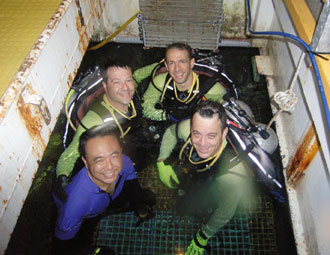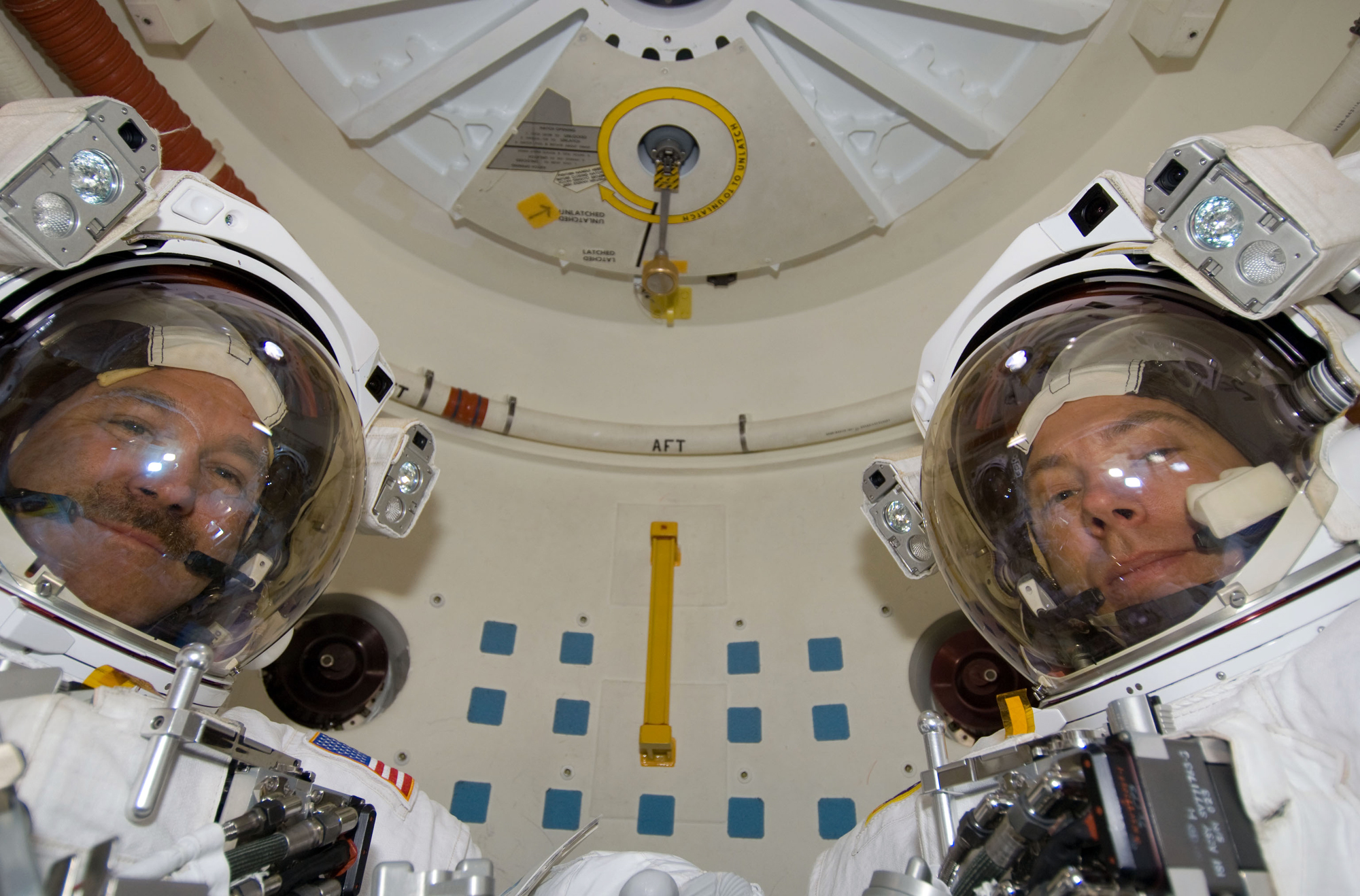|
Moon Pool
A moon pool is a feature of marine drilling platforms, drillships and diving support vessels, some marine research and underwater exploration or research vessels, and underwater habitats, in which it is also known as a wet porch. It is an opening in the floor or base of the hull, platform, or chamber giving access to the water below, allowing technicians or researchers to lower tools and instruments into the sea. It provides shelter and protection so that even if the ship is in high seas or surrounded by ice, researchers can work in comfort rather than on a deck exposed to the elements. A moon pool also allows divers, diving bells, ROVs, or small submersible craft to enter or leave the water easily and in a more protected environment. Moon pools can be used in chambers below sea level, especially for the use of scuba divers, and their design requires more complex consideration of air and water pressure acting on the moon pool surface. First use in oil drilling at sea Moon po ... [...More Info...] [...Related Items...] OR: [Wikipedia] [Google] [Baidu] |
RV Western Flyer
RV ''Western Flyer'' is a twin hulled SWATH research vessel operated by the Monterey Bay Aquarium Research Institute (MBARI). Its relatively stable SWATH design permits expanded operational capability in rough sea states. It is the platform of operations for the ROV ''Doc Ricketts'' (named after Ed Ricketts). The vessel carries 10 crew, 5 ROV pilots, and 11 scientists, for a total complement of 26. Cruises generally center around the central California coast and Monterey Bay, although excursions further afield to Hawaii, the Pacific Northwest, and the Gulf of California The Gulf of California ( es, Golfo de California), also known as the Sea of Cortés (''Mar de Cortés'') or Sea of Cortez, or less commonly as the Vermilion Sea (''Mar Bermejo''), is a marginal sea of the Pacific Ocean that separates the Baja Ca ... have taken place in recent years. Vessel description/ design characteristics General arrangement Accommodations are provided for a combination of 26 crew members an ... [...More Info...] [...Related Items...] OR: [Wikipedia] [Google] [Baidu] |
Pressure
Pressure (symbol: ''p'' or ''P'') is the force applied perpendicular to the surface of an object per unit area over which that force is distributed. Gauge pressure (also spelled ''gage'' pressure)The preferred spelling varies by country and even by industry. Further, both spellings are often used ''within'' a particular industry or country. Industries in British English-speaking countries typically use the "gauge" spelling. is the pressure relative to the ambient pressure. Various units are used to express pressure. Some of these derive from a unit of force divided by a unit of area; the SI unit of pressure, the pascal (Pa), for example, is one newton per square metre (N/m2); similarly, the pound-force per square inch (psi) is the traditional unit of pressure in the imperial and U.S. customary systems. Pressure may also be expressed in terms of standard atmospheric pressure; the atmosphere (atm) is equal to this pressure, and the torr is defined as of this. Manometric u ... [...More Info...] [...Related Items...] OR: [Wikipedia] [Google] [Baidu] |
Aquarius (laboratory)
The Aquarius Reef Base is an underwater habitat located 5.4 miles (9 kilometers) off Key Largo in the Florida Keys National Marine Sanctuary. It is deployed on the ocean floor 62 feet (19 meters) below the surface and next to a deep coral reef named Conch Reef. Aquarius is one of three undersea laboratories in the world dedicated to science and education. Two additional undersea facilities, also located in Key Largo, FL are owned and operated by Marine Resources Development Foundation. Aquarius was owned by the National Oceanic and Atmospheric Administration (NOAA) and operated by the University of North Carolina–Wilmington until 2013 when Florida International University assumed operational control. Florida International University (FIU) took ownership of Aquarius in October 2014. As part of the FIU Marine Education and Research Initiative, the Medina Aquarius Program is dedicated to the study and preservation of marine ecosystems worldwide and is enhancing the scope and i ... [...More Info...] [...Related Items...] OR: [Wikipedia] [Google] [Baidu] |
SEALAB (US Navy)
SEALAB I, II, and III were experimental underwater habitats developed by the United States Navy in the 1960s to prove the viability of saturation diving and humans living in isolation for extended periods of time. The knowledge gained from the SEALAB expeditions helped advance the science of deep sea diving and rescue, and contributed to the understanding of the psychological and physiological strains humans can endure. United States Navy Genesis Project Preliminary research work was undertaken by George F. Bond. Bond began investigations in 1957 to develop theories about saturation diving. Bond's team exposed rats, goats, monkeys, and human beings to various gas mixtures at different pressures. By 1963 they had collected enough data to test the first SEALAB habitat. SEALAB I SEALAB I was commanded by Captain Bond, who became known as "Papa Topside". SEALAB I proved that saturation diving in the open ocean was viable for extended periods. The experiment also offered informatio ... [...More Info...] [...Related Items...] OR: [Wikipedia] [Google] [Baidu] |
Airlock
An airlock, air-lock or air lock, often abbreviated to just lock, is a compartment with doors which can be sealed against pressure which permits the passage of people and objects between environments of differing pressure or atmospheric composition while minimizing the change of pressure in the adjoining spaces and mixing of environments. The lock consists of a relatively small chamber with two airtight doors in series which do not open simultaneously. An airlock may be used for passage between environments of different gases or different pressures, or both, to minimize pressure loss or prevent the gases from mixing. An airlock may also be used underwater to allow passage between an air environment in a pressure vessel and the water environment outside, in which case the airlock can contain air or water. This is called a floodable airlock or an underwater airlock, and is used to prevent water from entering a submersible vessel or an underwater habitat. Air-locks are used in ... [...More Info...] [...Related Items...] OR: [Wikipedia] [Google] [Baidu] |
Atmosphere (unit)
The standard atmosphere (symbol: atm) is a unit of pressure defined as Pa. It is sometimes used as a ''reference pressure'' or ''standard pressure''. It is approximately equal to Earth's average atmospheric pressure at sea level. History The standard atmosphere was originally defined as the pressure exerted by 760 mm of mercury at and standard gravity (''g''n = ). It was used as a reference condition for physical and chemical properties, and was implicit in the definition of the Celsius temperature scale, which defined as the boiling point of water at this pressure. In 1954, the 10th General Conference on Weights and Measures (CGPM) adopted ''standard atmosphere'' for general use and affirmed its definition of being precisely equal to dynes per square centimetre (). This defined both temperature and pressure independent of the properties of particular substance. In addition, the CGPM noted that there had been some misapprehension that it "led some physicists to believe ... [...More Info...] [...Related Items...] OR: [Wikipedia] [Google] [Baidu] |
Submarine
A submarine (or sub) is a watercraft capable of independent operation underwater. It differs from a submersible, which has more limited underwater capability. The term is also sometimes used historically or colloquially to refer to remotely operated vehicles and Autonomous underwater vehicle, robots, as well as medium-sized or smaller vessels, such as the midget submarine and the wet sub. Submarines are referred to as ''boats'' rather than ''ships'' irrespective of their size. Although experimental submarines had been built earlier, submarine design took off during the 19th century, and they were adopted by several navies. They were first widely used during World War I (1914–1918), and are now used in many navy, navies, large and small. Military uses include attacking enemy surface ships (merchant and military) or other submarines, and for aircraft carrier protection, Blockade runner, blockade running, Ballistic missile submarine, nuclear deterrence, reconnaissance, conventio ... [...More Info...] [...Related Items...] OR: [Wikipedia] [Google] [Baidu] |
Lock-out Chamber
A diving chamber is a vessel for human occupation, which may have an entrance that can be sealed to hold an internal pressure significantly higher than ambient pressure, a pressurised gas system to control the internal pressure, and a supply of breathing gas for the occupants. There are two main functions for diving chambers: * as a simple form of submersible vessel to transport divers underwater and to provide a temporary base and retrieval system in the depths; * as a land, ship or offshore platform-based hyperbaric chamber or system, to artificially reproduce the hyperbaric conditions under the sea. Internal pressures above normal atmospheric pressure are provided for diving-related applications such as saturation diving and diver decompression, and non-diving medical applications such as hyperbaric medicine. Basic types of diving chambers There are two basic types of submersible diving chambers, differentiated by the way in which the pressure in the diving chamber is pr ... [...More Info...] [...Related Items...] OR: [Wikipedia] [Google] [Baidu] |
Diving Bell
A diving bell is a rigid chamber used to transport divers from the surface to depth and back in open water, usually for the purpose of performing underwater work. The most common types are the open-bottomed wet bell and the closed bell, which can maintain an internal pressure greater than the external ambient. Diving bells are usually suspended by a cable, and lifted and lowered by a winch from a surface support platform. Unlike a submersible, the diving bell is not designed to move under the control of its occupants, nor to operate independently of its launch and recovery system. The wet bell is a structure with an airtight chamber which is open to the water at the bottom, that is lowered underwater to operate as a base or a means of transport for a small number of divers. Air is trapped inside the bell by pressure of the water at the interface. These were the first type of diving chamber, and are still in use in modified form. The closed bell is a pressure vessel for human ... [...More Info...] [...Related Items...] OR: [Wikipedia] [Google] [Baidu] |
Recreational Diving
Recreational diving or sport diving is diving for the purpose of leisure and enjoyment, usually when using scuba equipment. The term "recreational diving" may also be used in contradistinction to "technical diving", a more demanding aspect of recreational diving which requires more training and experience to develop the competence to reliably manage more complex equipment in the more hazardous conditions associated with the disciplines. Breath-hold diving for recreation also fits into the broader scope of the term, but this article covers the commonly used meaning of ''scuba diving for recreational purposes, where the diver is not constrained from making a direct near-vertical ascent to the surface at any point during the dive'', and risk is considered low. The equipment used for recreational diving is mostly open circuit scuba, though semi closed and fully automated electronic closed circuit rebreathers may be included in the scope of recreational diving. Risk is managed by tra ... [...More Info...] [...Related Items...] OR: [Wikipedia] [Google] [Baidu] |
Marine Salvage
Marine salvage is the process of recovering a ship and its cargo after a shipwreck or other maritime casualty. Salvage may encompass towing, re-floating a vessel, or effecting repairs to a ship. Today, protecting the coastal environment from spillage of oil or other contaminants is a high priority. Before the invention of radio, salvage services would be given to a stricken vessel by any ship that happened to be passing by. Nowadays, most salvage is carried out by specialist salvage firms with dedicated crew and equipment. The legal significance of salvage is that a successful salvor is entitled to a reward, which is a proportion of the total value of the ship and its cargo. The amount of the award is determined subsequently at a "hearing on the merits" by a maritime court in accordance with Articles 13 and 14 of the International Salvage Convention of 1989. The common law concept of salvage was established by the English Admiralty Court, and is defined as "a voluntary succe ... [...More Info...] [...Related Items...] OR: [Wikipedia] [Google] [Baidu] |
Underwater Habitat
Underwater habitats are underwater structures in which people can live for extended periods and carry out most of the basic human functions of a 24-hour day, such as working, resting, eating, attending to personal hygiene, and sleeping. In this context, 'habitat' is generally used in a narrow sense to mean the interior and immediate exterior of the structure and its fixtures, but not its surrounding marine environment. Most early underwater habitats lacked regenerative systems for air, water, food, electricity, and other resources. However, some underwater habitats allow for these resources to be delivered using pipes, or generated within the habitat, rather than manually delivered. An underwater habitat has to meet the needs of human physiology and provide suitable environmental conditions, and the one which is most critical is breathing air of suitable quality. Others concern the physical environment (pressure, temperature, light, humidity), the chemical environment (drink ... [...More Info...] [...Related Items...] OR: [Wikipedia] [Google] [Baidu] |







.jpg)